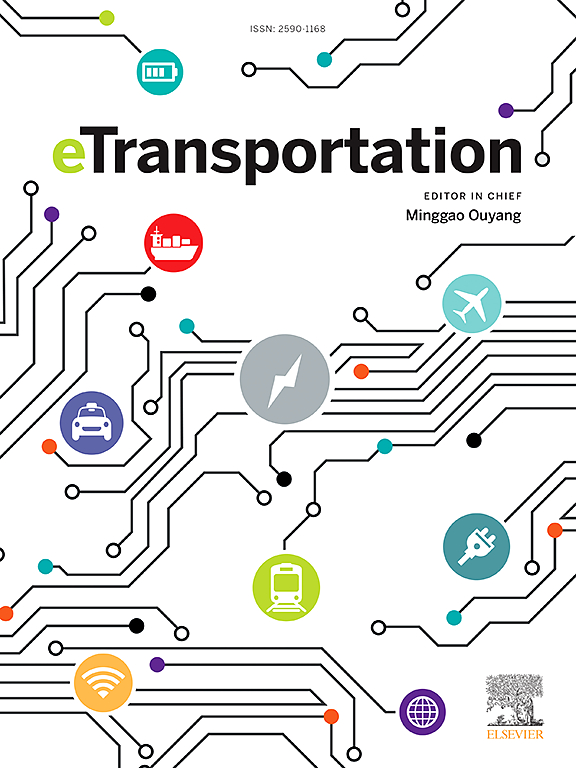锂离子电池热失控弹射电弧特性及产生机理
IF 17
1区 工程技术
Q1 ENERGY & FUELS
引用次数: 0
摘要
随着锂离子电池的广泛采用,电气故障的发生率呈上升趋势。虽然电弧故障通常与连接器松动或绝缘损坏有关,但它们在电池弹射过程中的潜在引发是电池安全领域一个重大且未解决的研究空白。本研究将电池加热至排气状态,研究放电电弧的特性及产生机理。结果表明:当电极间距为3 mm和5 mm时,在50 V及以上电压下可产生电弧;当电极间距为7 mm时,临界电压为200 ~ 400 V;如果喷出的碎片粘在电极表面,则电弧事件的数量增加,因为这相当于减少了电极间距。通过对每个电弧的电特性分析,确定了三种不同的电弧模式:粒子为主、片为主和组合为主。通过对电池弹射物电阻率的测量和粒子主导电弧的电阻估算,发现弹射物碎片在引发弹射电弧中起着比粒子更重要的作用。在此基础上,提出了基于临界电场强度的电弧安全边界,在400 V、800 V和1500 V典型电压下,电极安全间距分别为9.9 mm、14.0 mm和19.2 mm。研究结果有望为锂离子电池系统的安全设计提供有价值的指导。本文章由计算机程序翻译,如有差异,请以英文原文为准。

Characteristics and generation mechanism of ejecta-induced arc for lithium-ion battery during thermal runaway
As the widespread adoption of lithium-ion battery, the incidence of electrical faults is on the rise. While arc faults are commonly associated with loose connectors or damaged insulation, their potential initiation during battery ejection represents a significant and unaddressed research gap in the field of battery safety. In this study, the battery was heated to venting to investigate the characteristics and mechanism of ejecta-induced arc. The results show that the arc can be induced at voltage of 50 V and above under 3 mm and 5 mm electrode spacing, while the critical voltage ranges from 200 V to 400 V at 7 mm spacing. The number of arc events increase if the ejected pieces stuck on the electrode surface since it is equivalent to reduce the electrode spacing. Through the analysis of the electrical characteristics of each arc, three distinct arcing modes are identified: particles dominant, pieces dominant, and combination. Based on the measured resistivity of battery ejecta and resistance estimation of particles dominant arc, the pieces play a more important role than particles in the initiation of ejecta-induced arc. Furthermore, the safety boundary against ejecta-induced arc is proposed based on the critical electric field strength, and the safe electrode spacings for typical voltage of 400 V, 800 V, and 1500 V are 9.9 mm, 14.0 mm, and 19.2 mm, respectively. The results are expected to provide valuable guidance in safety design of lithium-ion battery systems.
求助全文
通过发布文献求助,成功后即可免费获取论文全文。
去求助
来源期刊

Etransportation
Engineering-Automotive Engineering
CiteScore
19.80
自引率
12.60%
发文量
57
审稿时长
39 days
期刊介绍:
eTransportation is a scholarly journal that aims to advance knowledge in the field of electric transportation. It focuses on all modes of transportation that utilize electricity as their primary source of energy, including electric vehicles, trains, ships, and aircraft. The journal covers all stages of research, development, and testing of new technologies, systems, and devices related to electrical transportation.
The journal welcomes the use of simulation and analysis tools at the system, transport, or device level. Its primary emphasis is on the study of the electrical and electronic aspects of transportation systems. However, it also considers research on mechanical parts or subsystems of vehicles if there is a clear interaction with electrical or electronic equipment.
Please note that this journal excludes other aspects such as sociological, political, regulatory, or environmental factors from its scope.
 求助内容:
求助内容: 应助结果提醒方式:
应助结果提醒方式:


